#with helpful side characters such as:
Text
who wants to hear about my perpetually in-progress almost-but-not-quite original wip abt a guy named nickei who is kind of The Fucking Worst (died and came back wrong in and they put him in charge of a fascist governmental organization)
#with helpful side characters such as:#agent frankenstein (who has so many issues). ren (rife with bloodlust & lichenburg scars)#bayler bynes (medic & drop out) and lilith (fucked up child) and dayton days (see: lilith's problems)#cherri.txt#i'm just thinkin abt revisiting the wip (i say with all of my papers of Lore spread around me.)#the disinformation age i love you. iridium city i love you. the A.R.C. initiative i hate you sm.#this wip is so self-indulgent its an amalgamation of all my favorite tropes n stuff
9 notes
·
View notes
Text
Types of side characters
1. Foil Characters: These side characters are designed to contrast with the main character, highlighting their qualities or flaws. Foil characters can provide a different perspective and challenge the main character's beliefs or actions.
2. Mentors or Guides: These side characters serve as mentors or guides to the main character, providing wisdom, guidance, and support. They often have more experience or knowledge in a specific area and help the main character navigate challenges or learn important lessons.
3. Comic Relief Characters: These side characters bring humor and levity to the story. They provide comedic relief during intense or serious moments and can help balance the overall tone of the narrative. Their wit, clumsiness, or unique personality traits make them enjoyable and entertaining.
4. Love Interests: Love interests are side characters who are romantically involved with the main character. They add a romantic subplot to the story and can contribute to the main character's personal growth and development. Love interests can be supportive, challenging, or even create conflict within the narrative.
5. Antagonists or Villains: Side characters can also take on the role of antagonists or villains. They oppose the main character's goals and create conflict and tension in the story. Antagonists can have their own motivations, complexities, and backstories, making them more than just one-dimensional obstacles.
6. Friends or Allies: These side characters are the main character's companions, friends, or allies. They provide emotional support, camaraderie, and assistance throughout the story. Friends or allies often share common goals and values, and their relationships can help showcase the main character's growth and strengths.
7. Family Members: Side characters who are family members of the main character can play significant roles in shaping their identity and backstory. They can provide emotional connections, conflict, and a sense of history within the narrative.
8. Background Characters: While not all side characters have to be highly developed, background characters help create a sense of realism and immersion in the story. They populate the world and add depth to the setting, even if they have minimal impact on the main plot.
9. Rivals or Competitors: These side characters compete with the main character, pushing them to improve, overcome obstacles, or achieve their goals. Rivals or competitors can be a source of conflict, motivation, and personal growth for the main character.
10. Witnesses or Observers: These side characters serve as witnesses or observers of the main events in the story. They may provide insights, commentary, or serve as a narrative device to convey information to the reader.
#writing#writer on tumblr#writerscommunity#writing tips#character development#writer tumblr#writblr#writing advice#oc character#writing help#creative writing#side characters
5K notes
·
View notes
Text
#bg3#baldur's gate 3#wyll ravengard#lae'zel#astarion#fun fact: when i saved this as a draft it only saved the astarion one but it saved all 3 of them as that one line for some reason#tbh something in me changed when lae'zel said that. i think that was the moment i really clicked with her#but wyll also goes hard as hell with that line#'why would a good-aligned character side with a devil?' BECAUSE SHE WAS OFFERING HELP AND THE GODS WERENT
2K notes
·
View notes
Text
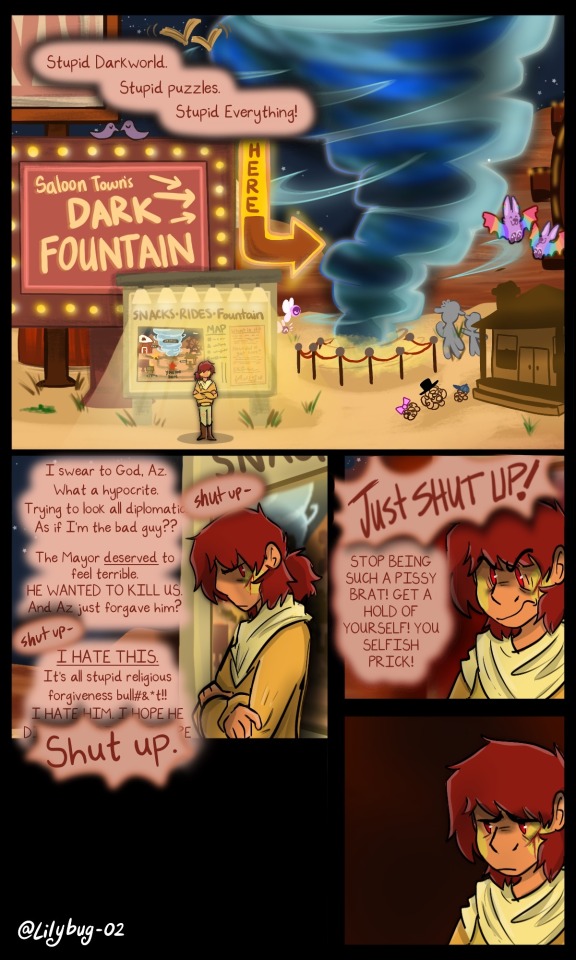
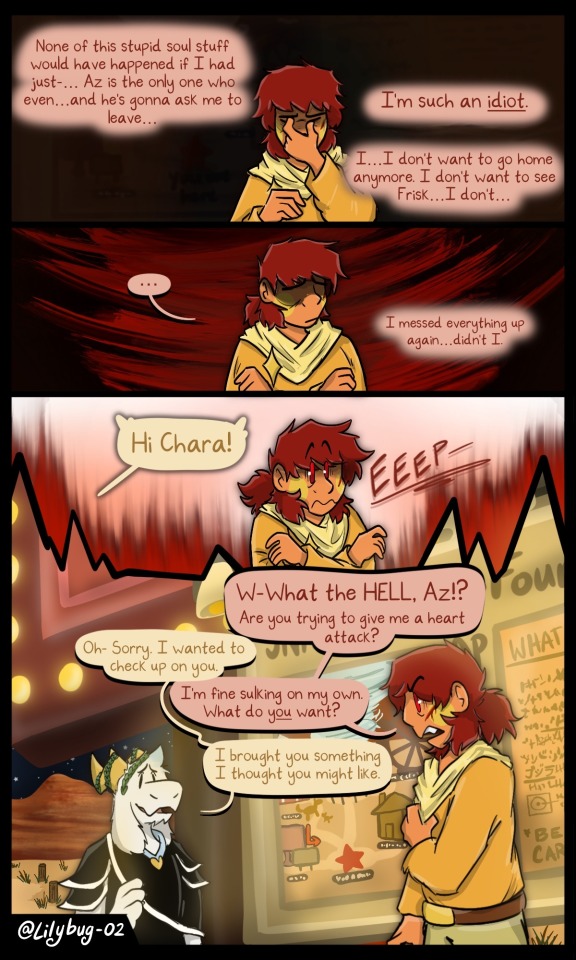

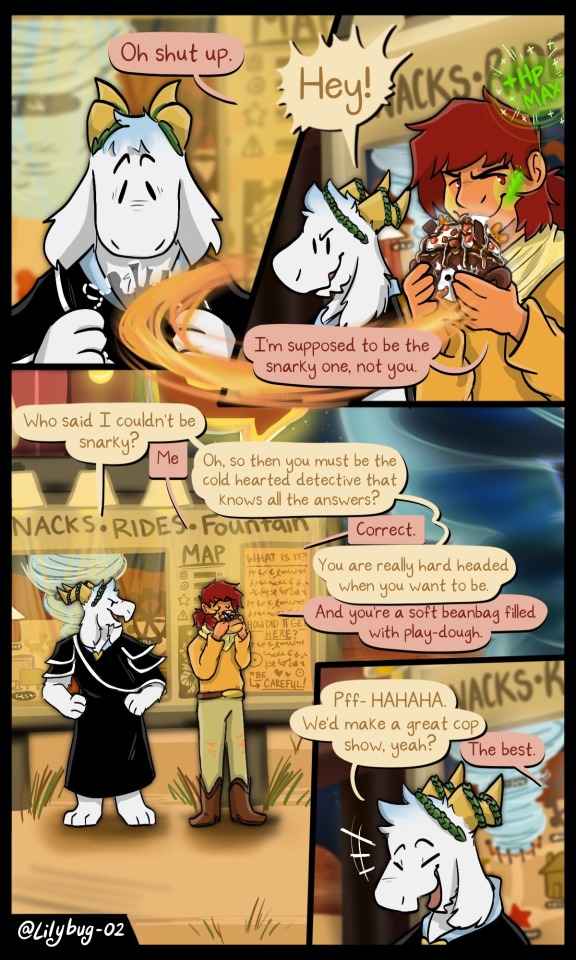

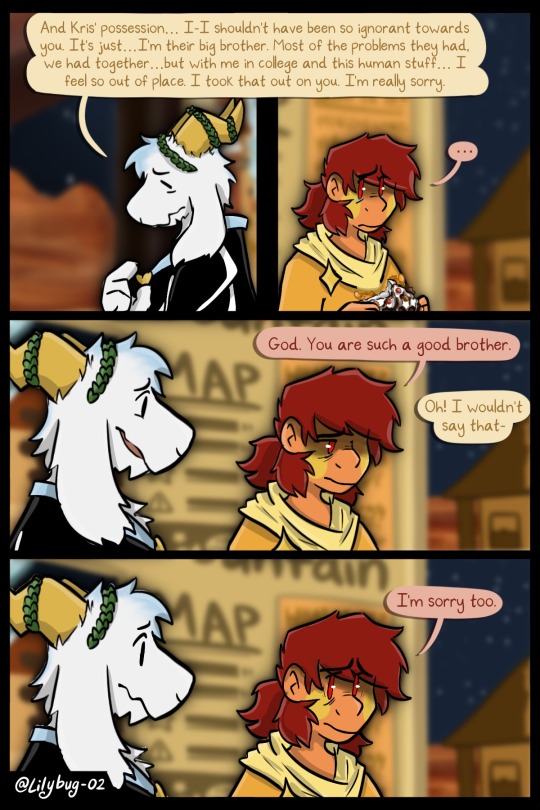
Bribed with Chocolate. The way it should be.
Part 22 || First || Previous || Next
--Full Series--
More to come as this is a two-parter. But you know how I am with schedules.
Bonus:
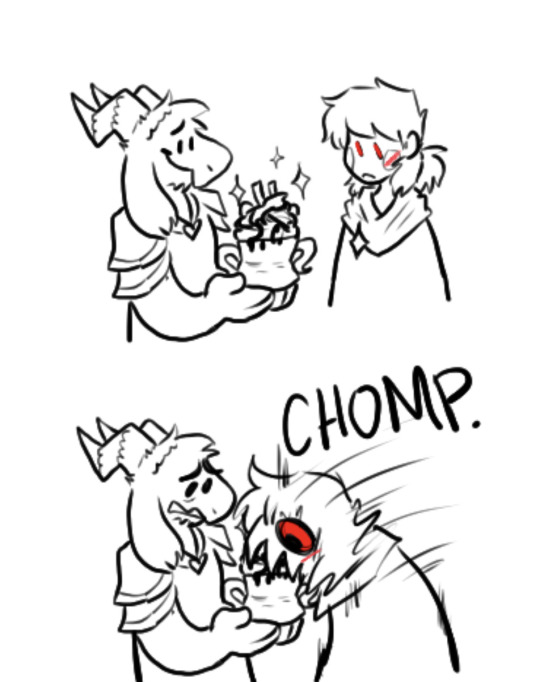
I think this was an equally possible reaction from Chara.
#Chara and Azzy have another talk#Finally Chara shows their mischievous side.#and Azzy knows Chara's language well#my art#deltarune chara timeline#art#bread#deltarune#ngl im so happy with how that chocolate shake came out. I want to eat it so bad#yay 6 pages of taking :') i hope you guys like that lmao#Glad I got this one done in basically a month and a week! Hah. I'm trying me best :') Halloween.. Exams and a ton of other things came up#surprisingly these backgrounds weren't terrible to do... I mean took more than two hours but you know what I mean#i struggled with how to frame the background though. I actually liked drawing it. But because both the background and my characters--#--are super colorful I have to make sure I don't muddle the whole page.#Ive been thinking of doing the overworld in black and white recently... may help me actually finish the comic lol. idk i may make a poll#gonna try and get the new part out in maybe a month again? sorry. Thanksgiving and Christmas get me exhausted.
1K notes
·
View notes
Text


*look* dear god *sighs intensely*
#jose pedro balmaceda pascal#pedro pascal characters#pedro pascal fandom#pedropascal#pedro pascal#tlou#joel miller the last of us#joel miller#the last of us hbo#tlou hbo#the last of us#help help help#this man is stealing my breath#ok but seriously#i could write a poem about his side profile#it's a masterpiece#i'm so obsessed#i can't stop thinking about it#and i'll never stop talking about it#softiedingo
960 notes
·
View notes
Text
some quick snowbaz sketches for the soul :)

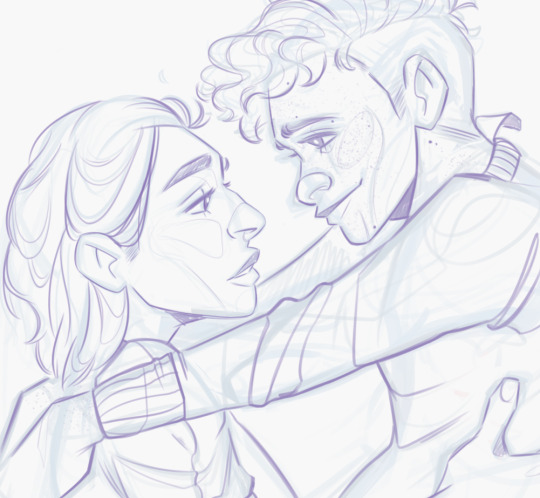
and also this lmfao

#been trying some new things lately#usually i do baz's hair up in a front middle part#bc ive always found it kinda fun and cartoony looking#but it was making his face look really fucking weird here so i tried drawing it down and back#+ parted to the side of his widow's peak instead#and i think i like it a lot better this way#ive also been trying to add more texture to his and simon's hair#to help make things a bit easier when im colouring#and i feel really fuckin good about how that turned out#like i have such a hard time drawing simon's fringe but i really like how it looks here#im also trying to overcome my fear of eyelashes lmfao#(and my general lack of confidence with drawing characters touching/interacting)#so yeah lots of fun new things happening here at the ''god i want to get better at art so bad'' club#n e way ->#carry on#simon snow#baz pitch#snowbaz#sketchbook apocalypse
252 notes
·
View notes
Text
how to write children's personalities
(this is part of my series, how to write children in fanfiction! feel free to check it out if you want more info like this!)
this is the main aspect of writing children that i see people mess up so often, especially in the fandoms i'm in (sanders sides and undertale). children are not adorable little noodles with no brains and no concept besides being cute and silly and crying. children are beings that are just as complex as adults, and they deserve personalities to match. this will make them way more interesting to read about! let's get started!
since there are so many aspects to personality to talk about and i don't want to sit here typing for ten years, we're going to do this guide a little differently. i'm going to divide these issues into archetypes, write a short description, and then make a list of do's and don't's for each one!
archetype one: the cute little baby
okay. babies are cute. we all know this, and i'm not saying it's a bad thing to make your babies cute. a lot of people love reading about moments with adorable little babies. but here are some ways to step this kind of thing up, and some things to avoid if you want to improve upon writing this archetype.
do's:
give the child character another archetype besides this one. though "cute" is the foundation for a lot of child characters, it's not a personality. and if a character is vital to your story, then it needs a personality. that's just a rule. you will read more about other archetypes further along in this post!
make the moments symbolic. though it doesn't seem like it from an outsider's perspective, basically everything a baby does is for a reason, and every action a baby makes can say something about their personality. if you want this baby's personality to be energetic and curious, have them crawl around and explore things, and laugh a lot, and babble. if you want this baby to be more sullen and shy, have them cry quietly instead of wailing, or have them squirm when being held by new people.
make the actions of the baby's guardians affect the mannerisms of the baby. babies act differently depending on how the people taking care of them act and react. for instance, if the baby's guardians are very busy people, then maybe have the baby cry very loudly whenever they want something, since they know that it's the only way to get the attention of their guardians. stuff like that can add depth to a character and to a general story.
don't's:
decide that the baby is cute and call it a day. sweet little babies are cool and all, but they get very boring to read about after a while. this can barely even be considered an archetype because of how bland it is when it's by itself.
keep this archetype around for too long. as babies turn into toddlers and then children, they don't act even remotely the same way. it's strange and off-putting to read about a seven year old acting like a two-year old, unless it's a very clear character choice that is a result of explicit actions and events.
make the baby know that it's cute. realistically, children don't understand the concept of cuteness until they're around toddler age. if then, you want to make the kid be like "i get what i want when i'm cute, so i'll act cute!", then sure, that's hilarious. but when they're two months old, they're not batting their eyelashes because that's their personality. they're batting their eyelashes because they got something in their eye. the main thing that makes a baby cute is that they don't know they're cute. they're just figuring out how to do ordinary things.
make everything a cute moment. while babies are awesome, raising them isn't always sunshine and rainbows. make the baby do something wildly chaotic, because babies do wildly chaotic things all the time. not only does this make things more realistic, but it makes things very interesting!
archetype two: the shy kid
as a former shy kid, i know good and well that these types of children exist, and they are very real and valid. however, there are certain ways i've seen them written that are just terrible because once again, this archetype cannot be considered a full personality on its own. let's get into the do's and don't's.
do's:
make their shyness a deliberate choice. kids aren't usually naturally shy. kids are usually more curious than cautious. is there a reason why the kid is shy? there doesn't have to be a reason why the kid is shy, but there could be a reason why the child is NOT outgoing/curious. try and give something like this some deliberate cause, instead of just making them shy so they can seem more precious and infantilized.
make their shyness manifest in diverse ways. not all shy kids cling to their guardian's leg and sit alone during recess. there are different ways to be shy. you can be aggressively shy, or fearfully shy, or shy due to general unwillingness to change.
make their shyness have realistic consequences. someone who's shy is probably not going to have many friends, if any. not all shy kids magically meet an extrovert who adopts them. someone who's shy probably has underdeveloped social skills, which can lead to them being less emotionally intelligent down the line. this makes the shy kid archetype a lot more three-dimensional than just a wet noodle of fear.
don't's:
infantilize shyness or treat it like it makes the kid some sweet, precious angel. not only is this very uncomfortable for shy people to read, but it's generally unrealistic. shyness doesn't affect how good or bad somebody is - it's a neutral trait.
use shyness as a tool to make characters seem younger. shyness does not indicate age. fear manifests in many different ways, and shyness is not the only way.
rely on cliches. not all shy people have the same journey, and the idea that a shy person becoming more outgoing is the "goal" is not only a bit offensive, but it's very cliche. shyness is not always an obstacle to be overcome.
archetype three: the happy-go-lucky kid
oftentimes, the reason why children characters are written into stories in the first place is to give a little bit of lightheartedness and innocence. to add a unique voice among all the cranky, stingy, burdened adults. but you have to be careful when writing this archetype. i personally really dislike this archetype as a whole, but i'm going to put personal feelings towards it aside because honestly, there's no valid reason to dislike it besides opinion.
do's:
give the kid a trademark. maybe this kid makes a lot of little jokes, or maybe they always see the best in a situation. give the kid one thing that makes them happy-go-lucky instead of just giving them everything because nobody is endlessly happy all the time in every way.
go deeper. while happiness is very often genuine, sometimes, it's a mask that hides something else. this can be an interesting way to sort of spice up your happy-go-lucky kid character. maybe the kid is hiding a big secret behind all those jokes.
don't's:
make the character always happy. while children tend to have simpler thoughts, they don't have simpler minds. this child needs to have thoughts, real, genuine thoughts that aren't just happy things.
see happy-go-lucky as a trait that is exclusive to children. comparing happiness to childhood and viewing them as the only places where the other can exist is just wrong, and it's kind of depressing. maybe give happy-go-lucky kid a happy-go-lucky adult to exchange jokes with!
---
those are the archetypes that i see a lot. but now, i'm going to suggest a few child character archetypes that i LOVE that i don't see enough in fics! feel free to use any of these that you like. alter them, combine them! these are, in my opinion, some of the most fun child character personalities!
the spoiled brat: "i want this, and that, and that, and- why aren't you giving it to me?? if you don't give me what i want, i'll tell on you!". spoiled brats are so fun to read and write about, especially when they have absolutely no reason to be spoiled given the current situation (think riches to rags). they've got everything, humor, angst, and best of all, lots of pockets for personality. think about why the child is spoiled. were they enabled by their guardians? did they grow up rich, with access to everything they wanted? think about whether you want the child to stay spoiled. does something change? do they learn how to improve their materialistic and selfish tendencies? there are so many opportunities to play with the personality of this child!
the know-it-all kid: while i do see a lot of know-it-all kids in media, oftentimes, they don't actually have personality besides bossiness and intelligence. i love know-it-all kids who have depth to them. kids who are constantly spouting information because of their sheer love to learn. kids who have one specific thing that they know everything about, so they never stop talking about it. kids who tell people what to do and act like they know best because they don't have a lot of control over anything at home, so they grasp at whatever control they can find elsewhere. i think this archetype could open up a lot of ideas for personality further down the line. it also has a lot of variety with humor and angst, and general depth.
the serious child: this is an archetype that i cannot get enough of. i love a child that doesn't think they're an adult, per se, and still enjoys kid things, but just has such a calm and regal air about them that isn't learned. it's just natural. think of the kid that doesn't really get excited about things conventionally, but you can tell they're happy by their faint smile. the kid that seems to live in slow motion, and doesn't mind this fact at all. the kid that sits alone at recess just because other kids scare the birds away, and they want to see how a bird acts when it doesn't think its being watched. i love kids who have poignant thoughts, because their thoughts are so creative and different from adult thoughts.
the adult-ified child: now this is another archetype i can't get enough of, but it's for a different reason. this child, on the other hand, does think that they're an adult for one reason or another. maybe their guardians forced them to grow up too quickly. maybe they just wanted to grow up quickly by themselves. but this child has thoughts that are too big for their little bodies. they explore things that aren't meant to be explored when their brains are still so small. they do everything too quickly, they stumble through life as if a clock is ticking somewhere. to me, they're just haunting to read about. it feels wrong and dangerous to just watch them do things that hurt them because they don't know any better, but they're on a page. nobody can stop them. it's just so tragic, i'm obsessed.
the prodigal child: this archetype isn't really as deep or detailed as the others, but i do appreciate it. this archetype is for a child who knew who they wanted to be from an early age. a child who wanders into a ballet class and finds out they're better than the ten year olds by the time they're five. this archetype often pairs really well with the know-it-all kid or the adult-ified child because usually, children don't experience what it's like to be the best at something until they're a lot older. this is just a really cool archetype when you aren't quite sure what to do with that main character's little sister.
the chaotic child: this archetype is so much fun to read and write, to be honest. this is a child that just does as they please, whether it's out of curiosity or for pure enjoyment. think of the crazy stories that your guardians have about you or your siblings being absolutely insane. scribbling in a book and then demanding that the library publish their version. trying to ride the dog like a horse. cutting up clothes in an attempt to be a fashion designer. this one is just plain fun!
---
now, there are so many more archetypes out there, but those are just my spotlights and recommendations! i hope after reading this, you feel more equipt to write child characters that have real, engaging, interesting personalities!
#not sanders sides#ez's writing#how to write children#how to write#writing#writing tips#writing guide#writing advice#writing resource#writing resources#personality#writing personality#do's and don't's#cliches#avoiding cliches#characterization#character concept#character tropes#character traits#character help
978 notes
·
View notes
Text

Help this trio + another guy was specifically designed to target me.
#villainess level 99#yumiella dolkness#patrick ashbatten#eleanora hillrose#i genuinely am so weak for these designs bc i love blonde menaces#i love side characters which helps a different blonde whomst i only met for like an episode#and i love patrick so much you guys i have adopted him#also im only through ep4 please dont spoil anything from the other eps#also uh outing myself as a fan of kon*suba and how the lead will just say yeah thats me when someone yells his name#so yeah have her just saying yes im 99 in spirit of he#okay i dont usually draw fanart of anime and idk if ill draw more but just .... these babies....#why do i like yellow bgs ? idk but i do
224 notes
·
View notes
Text
You know something? Out of all the ideas that the Danny Phantom fandom has mined the everloving shit out of, I feel that Blood Blossoms have not been mined as a concept NEARLY enough!
Because just like... A flower that hurts ghosts...? That's actually a pretty honest to Arceus interesting idea! Can different species of Blood Blossoms do the same thing? Are there different flowers in the genus that can effect ghosts differently...? Are there other herbal or traditional folk medicine type stuff that can also effect ghosts...? Like, in the human world, Danny Phantom ghosts are pretty OP. But there being stuff that just grows and lives naturally on Earth being able to repel or harm ghosts? That's actually just neat! I wanna see that stuff used more and to know how ghosts would have been fought against in ye olde times before all of this fancy technology came along!
#danny phantom#dp#blood blossoms#dpxdc#dc x dp#dp x dc crossover#danny phantom x dc#I also do think that in general that in DPxDC stuff in general that they pretend that ghosts have no flaws or weaknesses when like...#of course they do! they did in the original show! the justice league can deal with ghosts in some capacity! anyone can with the right stuff!#like I get that you don't want blorbo to get hurt... but like... there being weaknesses gives things stakes...? nothing wrong with that.#stakes are good actually and help people get invested. and my blorbos are in the DC side and I don't like when they appear entirely helpless#because they wouldn't be! i want the battlefield to be more even. and if the danny phantom side of things won't adopt the weaknesses DC#would give these characters according to canon and tgey won't be thoughtful and creative about it... Then I guess that I'll just have to!
202 notes
·
View notes
Text

beckory drawing of a scene from my fic =)
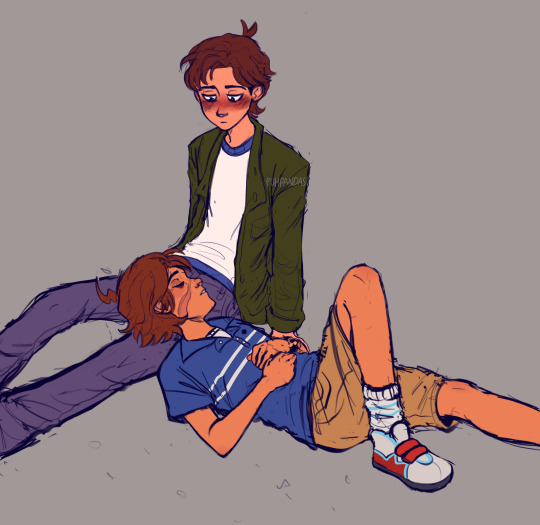
flat color bonus
#fun fact this was originally just going to be a drawing idea#but then i wrote a oneshot about the head in lap prompt#and now it can go with the one shot :)#drawing tag#beckory#gregtony#gregory#tony#my fics#happy to be your pillow#i tried sooo hard on gregory’s side profile#hope it looks like him#shoutout to the gay fanart of characters i dont know i saw on pinterest that helped me with the pose
271 notes
·
View notes
Text
sometimes i think about an AA universe where Edgeworth didn't have to be shuffled off every 5 seconds so he could maintain credibility as a rival....where Phoenix didn't have to win every case...yes AA is a game yes i understand why it did that for the narrative. but when I look at those lonely scared 24 year olds from AA1 i can't help but think that their version of a happy ending would be to be able to get used to each other. to face each other over stupid cases and small things. Sometimes one winning, sometimes the other, until it hardly matters anymore, all that matters is finding the truth together. I want them to take each other for granted!!! i want them to look at the other across the courtroom and say "time to face this bitch for the hundredth time i guess!!" these poor bastards have never had anything approaching emotional stability before let them have each other damn it
#idk im just. emotional#i feel like at that age?? at that place in their character development??? romance aside that would be legit be#the best happiest situation for both of them. and i feel things when i imagine it#we see so much of the grand gestures intense moments side of their relationship#they're always helping each other in their darkest moments and stuff like that but i wish they could also have#a very mundane professional dynamic. bitchy and prickly and earnest cause they both care a lot. and loving in their way#it's sad to me that so much of fic revolves around the idea that 'when phoenix and miles start dating miles will finally stay' thats#so tragic!!!!!!! am i the only person who thinks that's tragic#the game had to keep them apart for Narrative Reasons but i know my boy miles edgeworth and he would want to get bored of that spiky hairdo#and that handsome face. from seeing it in court so much.#narumitsu#wrightworth#phoenix wright#miles edgeworth#ace attorney#aa1#aa2 spoilers#aa3 spoilers
1K notes
·
View notes
Text
Thinking about how popular Mai would've been if she were a boy. Like, can you imagine?people would've swooned over her like they swoon over, idk, Jet—it just occured to me that I like her because she's so unconventional for a female character.
Girls like Mai exist in real world—but women are rarely allowed to be complex and three dimensional and grey in fiction.
I would argue that Mai is a grey character; she did start out as Azula's lackey. And well, that's a fictional girl; I found her apathy stan-worthy.
I love that she constantly has a bitch face. She cracks dry/dark jokes. Wears black. Is mysterious and stoic. Does everything she can to disregard authority/even though she's not confrontational about it. (There's one difference. Bad boys are usually very confrontational).
All these characteristics exist in popular male characters. (Except for one thing that I've noticed: most of these “bad boy” characters are volatile and yet, are described as broody/stoic, like, dude. That ain't stoic, that's so emotional.)
So yeah. Coming back to Mai. Imagine if she were a boy.
A boy who's apathetic and has no passion for anything. A boy who's constantly bored/a thrill-seeker/has nothing he cares about. A boy who has a shutter for a face and rarely expresses himself, is amazing with knives and hand-to-hand combat and is gloomy.
There's nothing he cares about because caring gets people hurt and everyone wants something and is two-faced so it's safe to be a mask of indifference. Until—hold on—until he meets a passionate, hot-headed girl who's ✨ different ✨and if not anything, wears her heart on her sleeve/is an open book...
Yes, I'm talking about Zuko.
...and oh, oh, would you look at that? Now he has something to fight for!
I mean, for Mai, Zuko (after Ty Lee) is the only other person in front of whom she can be herself.
Reminds me of “he's only nice to her” trope. Sorry.
“You're so beautiful when you hate the world.”
“I don't hate you.”
Just imagine Mai as a boy. People would eat it up. They don't like her 'cause she's a girl.
#mai#atla mai#avatar the last airbender#in defense of mai#i just felt like word vomiting#even zuko is described as broody#as if he wasn't constantly#and i mean CONSTANTLY#incapable of not expressing himself#plus mai was more apolitical than zuko#zuko was an active part of FN imperialism#and while mai did help azula#she always chose the path of least resistance#cue azula drilling a hole into ba sing se's wall#in what would be a historic victory for FN#and mai being like ew#azula can kill me later im not jumping in a drain#again not defending mai for helping azula#which is why i say she is a grey character#she's also a side character and hence did not get as much care/screen time as#say#someone like zuko
185 notes
·
View notes
Text
“The Jedi were wrong—” “The Jedi were right—” “Darth Vader is a villain—” “Darth Vader is a victim—”
The Jedi and Darth Vader are whatever the hell I need them to be to make the story happen get the fuck on my level
#star wars#jedi#darth vader#i do not give a shit about your disk horse#i will play whatever side of the argument i want or need to#to make my story happen#they are fictional characters and SO HELP ME GODS#they WILL serve the purposes of my plot!#i attach my emotional health to no fucking horse in this race#instead i feed them sugar cubes laced with lsd to make the race more interesting
548 notes
·
View notes
Note
what is a good way to introduce side characters into a story without being overly descriptive
Interesting characters are essential to telling a great story. While your main characters are the stars of the show, side characters play a crucial role in adding depth, complexity, and realism to your narrative. However, introducing these supporting players can be a challenge, especially if you want to avoid the dreaded info dump. Let’s explore some effective ways to introduce side characters without overwhelming your readers with too much information at once.
The importance of side characters
Before we dive into the techniques for introducing side characters, let’s take a moment to appreciate their significance. Side characters serve many purposes in a story, from providing comic relief to offering a fresh perspective on the main plot. They can also act as foils for your protagonists, highlighting their strengths and weaknesses through contrast. Additionally, well-developed side characters can make your fictional world feel more authentic and lived-in, as if it exists beyond the confines of the main storyline.
Introduce side characters gradually
One of the most effective ways to introduce side characters without info dumping is to do so gradually. Instead of bombarding your readers with a character’s entire life story in one go, reveal details about them over time. Start with a brief description of their appearance, mannerisms, or role in the story, and then sprinkle in additional information as the narrative progresses. This approach allows readers to get to know the character organically, just as they would in real life.
Show, don’t tell
While it’s almost cliché now, another key strategy for introducing side characters is to show, rather than tell, who they are. Instead of simply listing a character’s attributes or history, demonstrate who they are through their actions, dialogue, and interactions with other characters. This allows readers to draw their own conclusions about the character based on what they observe, rather than being told what to think.
Use dialogue to reveal character
Dialogue is another powerful tool for introducing side characters without info dumping. Through conversations with other characters, side characters can reveal their personalities, motivations, and backstories in a natural and organic way. This allows you to convey important information without resorting to lengthy exposition or narration. For example, a side character might mention a past experience or share an opinion that sheds light on their worldview. By weaving these details into the dialogue, you can create a more nuanced and believable portrayal of the character.
Connect side characters to the main plot
To make side characters feel integral to your story, it’s important to connect them to the main plot in meaningful ways. Rather than having them exist in a vacuum, show how their actions and decisions impact the central narrative. This not only makes the side characters more relevant but also helps to create a more cohesive and interconnected story. For instance, a side character’s seemingly minor decision could inadvertently set off a chain of events that alters the course of the main plot. By establishing these connections, you give readers a reason to care about the side characters and their roles in the story.
Include a subplot
You can develop your side characters by writing them into a subplot. By giving them their own storylines that intersect with the main plot, you create opportunities to explore their motivations, challenges, and growth. These subplots can also serve to heighten the stakes of the main narrative, as the actions of side characters may have unintended consequences that ripple throughout the story. By carefully crafting these subplots, you can add depth and complexity to your side characters without overwhelming the reader.
Summing up
Introducing side characters without info dumping is a skill that takes practice and finesse. By revealing details gradually, showing rather than telling, using dialogue effectively, and connecting side characters to the main plot, you can create a rich and immersive fictional world that feels authentic and engaging.
Remember, side characters are more than just background noise; they are an essential part of any great story. By giving them the attention and development they deserve, you’ll take your writing to the next level and keep your readers coming back for more.
#writing asks#character development#side characters#subplot#writing advice#writing tips#writers#creative writing#writing#writing community#writers of tumblr#creative writers#writing inspiration#writeblr#writerblr#writing blog#writblr#novlr#writers on tumblr#writer stuff#writers and poets#writing resources#on writing#writing tip#tips for writers#helping writers#help for writers#writing help#resources for writers#writer
93 notes
·
View notes
Text
Stiles: Um, sure. Let's see...hmmm...Oh! If you see a drowsy looking bee on the ground, you can give it a little drop of sugar water to help make it feel better.
Derek, in the middle of cleaning out a bullet wound:
Stiles:
Stiles: I'm now starting to realize that you were probably asking me for a "Q-Tip" rather than a "cute tip".
#sterek#teen wolf#derek hale#stiles stilinski#tyler hoechlin#dylan o'brien#mieczysław stiles stilinski#incorrect teen wolf quotes#incorrect quotes#incorrect teen wolf#Stiles: Sorry. That's my bad.#Derek: No no. I didn't realize how much I needed to hear that today. That was delightful. Thank you.#Derek: But yes. I would also very much appreciate a Q-tip if you wouldn't mind. That would be very helpful right now.#Speaking of cute tips: you can buy stickers of your kids' favorite characters and stick them to veggies at the store#Your kids will be more willing to eat them if they think you're buying “Avengers Brand” zucchini or “Paw Patrol Brand” carrots#Also if your cat likes to sit on your laptop while you work hook up a wireless keyboard and quietly type to the side as you pet your cat
628 notes
·
View notes
Text
i keep thinking about the datamined conversation between halsin and minthara and what gets me about it is that if you side with halsin and turn minthara away, thats objectively the bad choice.
like at this point, you've rescued minthara from moonrise. you know now that she was being controlled to act against her will. you've gone to the trouble of rescuing her from her tormentors, and you've experienced what it felt like as they tried to destroy her mind. you know what will happen to her if you turn her away. and if you do, you're willingly condemning her to that fate. you've essentially allowed her to experience freedom, to regain her sense of self, only to tear that away from her again.
whereas if you side with minthara, and halsin leaves, that's the only consequence he experiences. that he's not a companion anymore. at this point, we've saved the grove, we've saved him, and we've lifted the shadow curse. we've helped him achieve what hes been hoping to do for over a century. leaving your party won't see him lose his free will. he can return to the grove and live his life.
the choice is essentially either condemn someone to a fate worse than death, knowing exactly what that entails vs not letting someone travel with you anymore. its pretty clear cut to me.
its just interesting to me that they've switched the morality of it around given that minthara is considered the 'evil' companion by so many.
#baldur's gate 3#baldur's gate 3 spoilers#bg3 spoilers#minthara#minthara baenre#before anyone comes at me and says that halsin is allowed to have his prejudice and his trauma. im not saying hes not#not sure about someone being allowed to have prejudice but yes thats part of human nature i guess#my point isnt that hes not allowed to react like this#my point is that hes wrong.#sure he can be struggling with his trauma and his prejudice over minthara being a lolth sworn (even if shes not anymore)#BUT. at this point we as a character /know/ theres more to her. we know that hes making an unfair assessment of her#which is even more jarring if you're a drow/lolth sworn drow#and at this point. you've saved the grove youve saved him youve helped him break the curse. he tells you its a debt he cant repay#and that hes so thankful. but he wont trust you or your decision. he won't even attempt to#and u know what thats fine. he doesnt have to. but if you're siding with him you're condemning her. you're killing her#if you side against him. he can go back to his responsibilities as an arch druid rather than leaving it in someone elses hands (which was?)#that is the lesser of the two evils here#yes you can call minthara the 'evil' character because shes a lolth sworn but thats just buying into the prejudice halsin is showing#and its wrong#anyways. my point is good for him if he wants to demand you make a ridiculous choice#but turning her away is the bad choice and tbh i feel like the game wants u to know that#and sure if you want to boil it down to which character u like more than the other and u prefer halsin. ur obvs gonna side with him#but in that case u probably wouldn't even get this conversation#because why would u have bothered to spare / save minthara in the first place?
199 notes
·
View notes